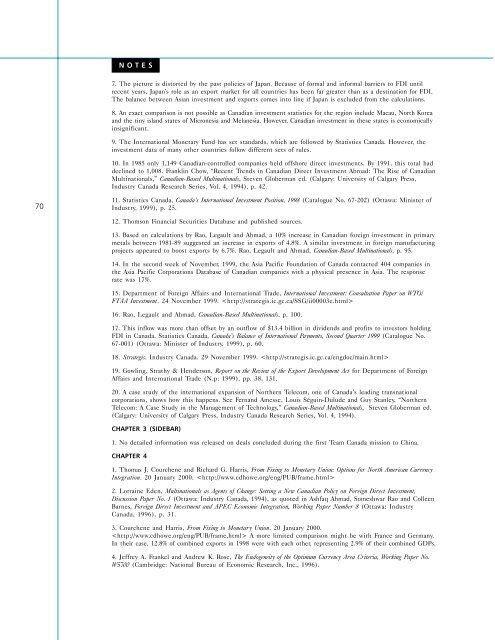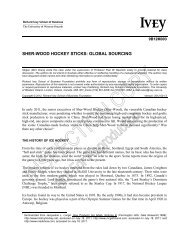foundation of canada asia pacific - Content Tagged with
foundation of canada asia pacific - Content Tagged with
foundation of canada asia pacific - Content Tagged with
Create successful ePaper yourself
Turn your PDF publications into a flip-book with our unique Google optimized e-Paper software.
NOTES<br />
7. The picture is distorted by the past policies <strong>of</strong> Japan. Because <strong>of</strong> formal and informal barriers to FDI until<br />
recent years, Japan’s role as an export market for all countries has been far greater than as a destination for FDI.<br />
The balance between Asian investment and exports comes into line if Japan is excluded from the calculations.<br />
8. An exact comparison is not possible as Canadian investment statistics for the region include Macau, North Korea<br />
and the tiny island states <strong>of</strong> Micronesia and Melanesia. However, Canadian investment in these states is economically<br />
insignificant.<br />
9. The International Monetary Fund has set standards, which are followed by Statistics Canada. However, the<br />
investment data <strong>of</strong> many other countries follow different sets <strong>of</strong> rules.<br />
10. In 1985 only 1,149 Canadian-controlled companies held <strong>of</strong>fshore direct investments. By 1991, this total had<br />
declined to 1,008. Franklin Chow, “Recent Trends in Canadian Direct Investment Abroad: The Rise <strong>of</strong> Canadian<br />
Multinationals,” Canadian-Based Multinationals, Steven Globerman ed. (Calgary: University <strong>of</strong> Calgary Press,<br />
Industry Canada Research Series, Vol. 4, 1994), p. 42.<br />
70<br />
11. Statistics Canada, Canada’s International Investment Position, 1998 (Catalogue No. 67-202) (Ottawa: Minister <strong>of</strong><br />
Industry, 1999), p. 25.<br />
12. Thomson Financial Securities Database and published sources.<br />
13. Based on calculations by Rao, Legault and Ahmad, a 10% increase in Canadian foreign investment in primary<br />
metals between 1981-89 suggested an increase in exports <strong>of</strong> 4.8%. A similar investment in foreign manufacturing<br />
projects appeared to boost exports by 6.7%. Rao, Legault and Ahmad, Canadian-Based Multinationals, p. 95.<br />
14. In the second week <strong>of</strong> November, 1999, the Asia Pacific Foundation <strong>of</strong> Canada contacted 404 companies in<br />
the Asia Pacific Corporations Database <strong>of</strong> Canadian companies <strong>with</strong> a physical presence in Asia. The response<br />
rate was 17%.<br />
15. Department <strong>of</strong> Foreign Affairs and International Trade, International Investment: Consultation Paper on WTO/<br />
FTAA Investment. 24 November 1999. <br />
16. Rao, Legault and Ahmad, Canadian-Based Multinationals, p. 100.<br />
17. This inflow was more than <strong>of</strong>fset by an outflow <strong>of</strong> $13.4 billion in dividends and pr<strong>of</strong>its to investors holding<br />
FDI in Canada. Statistics Canada, Canada’s Balance <strong>of</strong> International Payments, Second Quarter 1999 (Catalogue No.<br />
67-001) (Ottawa: Minister <strong>of</strong> Industry, 1999), p. 60.<br />
18. Strategis. Industry Canada. 29 November 1999. <br />
19. Gowling, Strathy & Henderson, Report on the Review <strong>of</strong> the Export Development Act for Department <strong>of</strong> Foreign<br />
Affairs and International Trade (N.p: 1999), pp. 38, 131.<br />
20. A case study <strong>of</strong> the international expansion <strong>of</strong> Northern Telecom, one <strong>of</strong> Canada’s leading transnational<br />
corporations, shows how this happens. See Fernand Amesse, Louis Séguin-Dulude and Guy Stanley, “Northern<br />
Telecom: A Case Study in the Management <strong>of</strong> Technology,” Canadian-Based Multinationals, Steven Globerman ed.<br />
(Calgary: University <strong>of</strong> Calgary Press, Industry Canada Research Series, Vol. 4, 1994).<br />
CHAPTER 3 (SIDEBAR)<br />
1. No detailed information was released on deals concluded during the first Team Canada mission to China.<br />
CHAPTER 4<br />
1. Thomas J. Courchene and Richard G. Harris, From Fixing to Monetary Union: Options for North American Currency<br />
Integration. 20 January 2000. <br />
2. Lorraine Eden, Multinationals as Agents <strong>of</strong> Change: Setting a New Canadian Policy on Foreign Direct Investment,<br />
Discussion Paper No. 1 (Ottawa: Industry Canada, 1994), as quoted in Ashfaq Ahmad, Someshwar Rao and Colleen<br />
Barnes, Foreign Direct Investment and APEC Economic Integration, Working Paper Number 8 (Ottawa: Industry<br />
Canada, 1996), p. 31.<br />
3. Courchene and Harris, From Fixing to Monetary Union. 20 January 2000.<br />
A more limited comparison might be <strong>with</strong> France and Germany.<br />
In their case, 12.8% <strong>of</strong> combined exports in 1998 were <strong>with</strong> each other, representing 2.9% <strong>of</strong> their combined GDPs.<br />
4. Jeffrey A. Frankel and Andrew K. Rose, The Endogeneity <strong>of</strong> the Optimum Currency Area Criteria, Working Paper No.<br />
W5700 (Cambridge: National Bureau <strong>of</strong> Economic Research, Inc., 1996).



